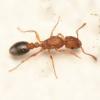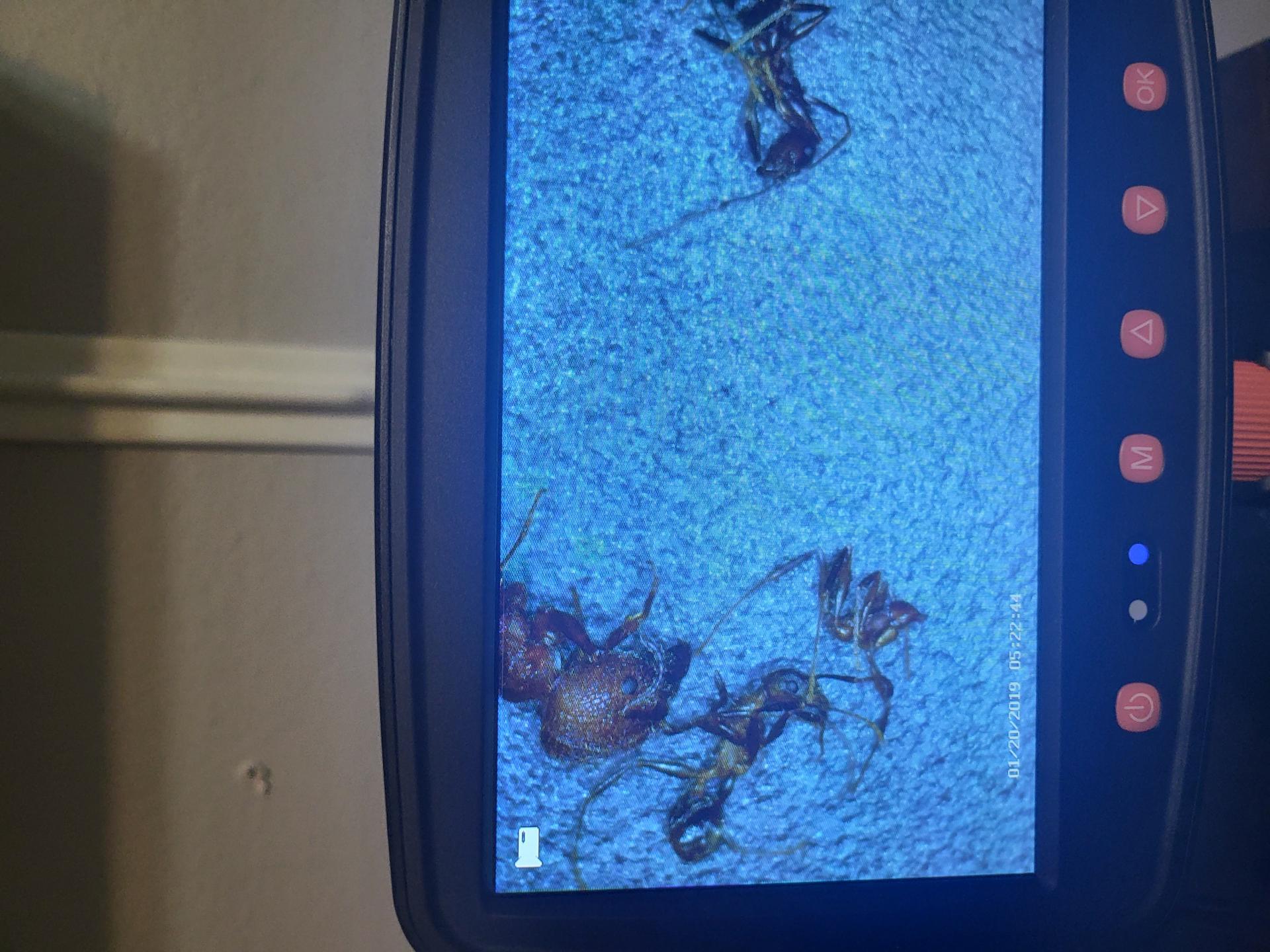- Formiculture.com
- Forums
- Gallery
- Members
- Member Map
- Chat

New species maybe?
Started By
JesseTheAntKid
, Jan 15 2024 12:12 PM
8 replies to this topic
#1
 Offline
-
Posted January 15 2024 - 12:12 PM
Offline
-
Posted January 15 2024 - 12:12 PM
Let me start off with a detailed description.
Some sort of Pheidole species. A major is around 4 mm average length. The majors have red hues all around, with a black faded abdomen. Their legs are reddish, with faded yellow segments leading to the thorax, which has two bumps, the first one bigger and the second one smaller. Two joints are connected to the bigger bump. It has a two-segmented petiole. The first one is a vaguely camelback shaped segment, the second one being simply a curved bump. The abdomen is somewhat although not completely flattened and faces downwards. The majors' head has curved-down mandibles. The head is heart-shaped, vaguely, and is red as well with black fades leading to the mandibles. The antennae segments are hard to count, but with a good estimate, I counted 10 segments. Minors are roughly 3 mm in length. Their colors can range from black, rich purplish red, orange, red, rich red, or any combination of these. The petioles and general structure of the body are the same as the majors, except of course for the color. Legs in minors are long and spindly, and antennae are also somewhat unusually long for the size, though not as unusually long as Paratrechina longicornis'. The minors head is roughly 1/4 the size of the body, and the majors head is roughly 1/2 the size of their body.
Could this be a new species?
Some sort of Pheidole species. A major is around 4 mm average length. The majors have red hues all around, with a black faded abdomen. Their legs are reddish, with faded yellow segments leading to the thorax, which has two bumps, the first one bigger and the second one smaller. Two joints are connected to the bigger bump. It has a two-segmented petiole. The first one is a vaguely camelback shaped segment, the second one being simply a curved bump. The abdomen is somewhat although not completely flattened and faces downwards. The majors' head has curved-down mandibles. The head is heart-shaped, vaguely, and is red as well with black fades leading to the mandibles. The antennae segments are hard to count, but with a good estimate, I counted 10 segments. Minors are roughly 3 mm in length. Their colors can range from black, rich purplish red, orange, red, rich red, or any combination of these. The petioles and general structure of the body are the same as the majors, except of course for the color. Legs in minors are long and spindly, and antennae are also somewhat unusually long for the size, though not as unusually long as Paratrechina longicornis'. The minors head is roughly 1/4 the size of the body, and the majors head is roughly 1/2 the size of their body.
Could this be a new species?
Currently keeping: Pheidole obscurithorax (FINALLY I CAN STUDY THEM AND HAVE THEIR COOL MAJORS ![]() ), Tetramorium bicarinatum, Solenopsis spp. (probably xyloni, the queens are tiny hehe)
), Tetramorium bicarinatum, Solenopsis spp. (probably xyloni, the queens are tiny hehe)
Wanting: Atta texana, Camponotus planatus (PLEASE PLEASE PLEASE CAN SOMEONE HOOK ME UP WITH ATTA)
Previously kept: Monomorium minimum, Pheidole dentata
"ATTAAAAAAAAAAAA!!!!!!!!!!!" -Me
"AAAAAAAATTTTTTTTTAAAAAAAAAAAAAAAAAAAAAAAAAA!!!!!!!!!!!!!!!!!!!!!!!!!!!!!!!!!!!!!!!!!!!!!!!!" -Even more me
"AAAAAAAAAAAAAAAAAAAAAAAAAATTTTTTTTTTTTTTTTTTTTTTTTTTTTTTTTTAAAAAAAAAAAAAAAAAAAAAAAAAAAAAAAAAAAAAAAAAAAAAAAAA!!!!!!!!!!!!!!!!!!!!!!!!!!!!!!!!!!!!!!!!!!!!!!!!!!!!!!!!!"- Me personified
#2
 Offline
-
Posted January 15 2024 - 1:02 PM
Offline
-
Posted January 15 2024 - 1:02 PM
With Pheidole anything is possible. Good pictures would help.
- ReignofRage likes this
#3
 Offline
-
Posted January 15 2024 - 1:33 PM
Offline
-
Posted January 15 2024 - 1:33 PM
Currently keeping: Pheidole obscurithorax (FINALLY I CAN STUDY THEM AND HAVE THEIR COOL MAJORS ![]() ), Tetramorium bicarinatum, Solenopsis spp. (probably xyloni, the queens are tiny hehe)
), Tetramorium bicarinatum, Solenopsis spp. (probably xyloni, the queens are tiny hehe)
Wanting: Atta texana, Camponotus planatus (PLEASE PLEASE PLEASE CAN SOMEONE HOOK ME UP WITH ATTA)
Previously kept: Monomorium minimum, Pheidole dentata
"ATTAAAAAAAAAAAA!!!!!!!!!!!" -Me
"AAAAAAAATTTTTTTTTAAAAAAAAAAAAAAAAAAAAAAAAAA!!!!!!!!!!!!!!!!!!!!!!!!!!!!!!!!!!!!!!!!!!!!!!!!" -Even more me
"AAAAAAAAAAAAAAAAAAAAAAAAAATTTTTTTTTTTTTTTTTTTTTTTTTTTTTTTTTAAAAAAAAAAAAAAAAAAAAAAAAAAAAAAAAAAAAAAAAAAAAAAAAA!!!!!!!!!!!!!!!!!!!!!!!!!!!!!!!!!!!!!!!!!!!!!!!!!!!!!!!!!"- Me personified
#4
 Offline
-
Posted January 15 2024 - 2:43 PM
Offline
-
Posted January 15 2024 - 2:43 PM
A locale would be very helpful, along with frontal face images if you're able to get them.
Edited by ReignofRage, January 15 2024 - 2:43 PM.
- gcsnelling likes this
#5
 Offline
-
Posted January 15 2024 - 6:51 PM
Offline
-
Posted January 15 2024 - 6:51 PM
Locale: Houston
Currently keeping: Pheidole obscurithorax (FINALLY I CAN STUDY THEM AND HAVE THEIR COOL MAJORS ![]() ), Tetramorium bicarinatum, Solenopsis spp. (probably xyloni, the queens are tiny hehe)
), Tetramorium bicarinatum, Solenopsis spp. (probably xyloni, the queens are tiny hehe)
Wanting: Atta texana, Camponotus planatus (PLEASE PLEASE PLEASE CAN SOMEONE HOOK ME UP WITH ATTA)
Previously kept: Monomorium minimum, Pheidole dentata
"ATTAAAAAAAAAAAA!!!!!!!!!!!" -Me
"AAAAAAAATTTTTTTTTAAAAAAAAAAAAAAAAAAAAAAAAAA!!!!!!!!!!!!!!!!!!!!!!!!!!!!!!!!!!!!!!!!!!!!!!!!" -Even more me
"AAAAAAAAAAAAAAAAAAAAAAAAAATTTTTTTTTTTTTTTTTTTTTTTTTTTTTTTTTAAAAAAAAAAAAAAAAAAAAAAAAAAAAAAAAAAAAAAAAAAAAAAAAA!!!!!!!!!!!!!!!!!!!!!!!!!!!!!!!!!!!!!!!!!!!!!!!!!!!!!!!!!"- Me personified
#6
 Offline
-
Posted January 15 2024 - 7:29 PM
Offline
-
Posted January 15 2024 - 7:29 PM
Assuming you mean Houston, TX, you may want to check out Pheidole obscurithorax as an option of what it could be. Inaturalist & Antweb
- OiledOlives likes this
#7
 Offline
-
Posted January 17 2024 - 5:05 PM
Offline
-
Posted January 17 2024 - 5:05 PM
dang it, it is pheidole obscurithorax. It's not even native...
Currently keeping: Pheidole obscurithorax (FINALLY I CAN STUDY THEM AND HAVE THEIR COOL MAJORS ![]() ), Tetramorium bicarinatum, Solenopsis spp. (probably xyloni, the queens are tiny hehe)
), Tetramorium bicarinatum, Solenopsis spp. (probably xyloni, the queens are tiny hehe)
Wanting: Atta texana, Camponotus planatus (PLEASE PLEASE PLEASE CAN SOMEONE HOOK ME UP WITH ATTA)
Previously kept: Monomorium minimum, Pheidole dentata
"ATTAAAAAAAAAAAA!!!!!!!!!!!" -Me
"AAAAAAAATTTTTTTTTAAAAAAAAAAAAAAAAAAAAAAAAAA!!!!!!!!!!!!!!!!!!!!!!!!!!!!!!!!!!!!!!!!!!!!!!!!" -Even more me
"AAAAAAAAAAAAAAAAAAAAAAAAAATTTTTTTTTTTTTTTTTTTTTTTTTTTTTTTTTAAAAAAAAAAAAAAAAAAAAAAAAAAAAAAAAAAAAAAAAAAAAAAAAA!!!!!!!!!!!!!!!!!!!!!!!!!!!!!!!!!!!!!!!!!!!!!!!!!!!!!!!!!"- Me personified
#8
 Offline
-
Posted January 19 2024 - 5:49 AM
Offline
-
Posted January 19 2024 - 5:49 AM
Wait. Maybe it's not. The abdomen for Pheidole obscurithorax is too large, and the color is too monoform. These ants are variable from A to Z.
Currently keeping: Pheidole obscurithorax (FINALLY I CAN STUDY THEM AND HAVE THEIR COOL MAJORS ![]() ), Tetramorium bicarinatum, Solenopsis spp. (probably xyloni, the queens are tiny hehe)
), Tetramorium bicarinatum, Solenopsis spp. (probably xyloni, the queens are tiny hehe)
Wanting: Atta texana, Camponotus planatus (PLEASE PLEASE PLEASE CAN SOMEONE HOOK ME UP WITH ATTA)
Previously kept: Monomorium minimum, Pheidole dentata
"ATTAAAAAAAAAAAA!!!!!!!!!!!" -Me
"AAAAAAAATTTTTTTTTAAAAAAAAAAAAAAAAAAAAAAAAAA!!!!!!!!!!!!!!!!!!!!!!!!!!!!!!!!!!!!!!!!!!!!!!!!" -Even more me
"AAAAAAAAAAAAAAAAAAAAAAAAAATTTTTTTTTTTTTTTTTTTTTTTTTTTTTTTTTAAAAAAAAAAAAAAAAAAAAAAAAAAAAAAAAAAAAAAAAAAAAAAAAA!!!!!!!!!!!!!!!!!!!!!!!!!!!!!!!!!!!!!!!!!!!!!!!!!!!!!!!!!"- Me personified
#9
 Offline
-
Posted January 19 2024 - 1:01 PM
Offline
-
Posted January 19 2024 - 1:01 PM
If you check out the Inaturalist link to all P. obscurithorax observations, you'll see that their color varies a lot and includes th colors you described. Gaster size may vary from specimen to specimen based ont he amount of food they have inside.
- ZATrippit likes this
1 user(s) are reading this topic
0 members, 1 guests, 0 anonymous users
















